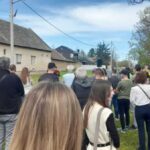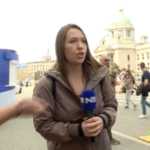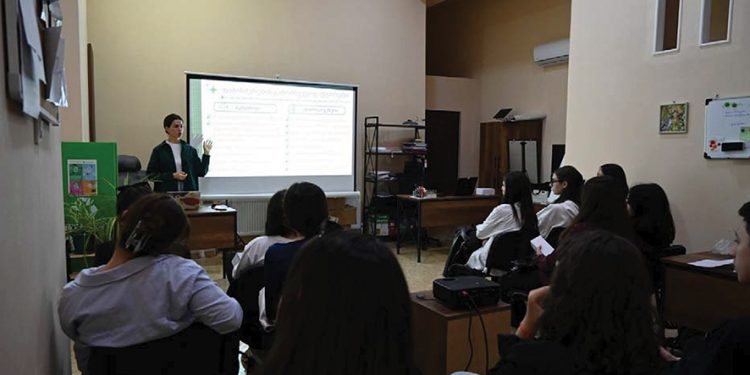I would like to share with you my experience on October 10, at the Eco Centre, Rustavi. I took part in a training session focusing on environmental issues. This was part of a project called ‘Accelerating Ecological Development: Raising awareness and Promoting Sustainable Waste Management’.
We, a group of teens from Tbilisi, Rustavi and other cities, came together to discuss air pollution, plastic pollution and ways to live sustainably. The session included fun educational games to help us learn about the topics. We also had discussions on our roles in creating a healthy environment.
Take a closer look at our findings and see how we can contribute to a more sustainable future.
What Did We Learn from Our Experience?
Our main topics included air quality, plastic contamination, and how to live in an eco-friendly manner.
Airborne particulate Matter (PM) was one of the topics we discussed. PM is not just one type; it’s a mixture of tiny particles in air, some of them harmful to our health. We learned about two types:
* PM10: These are particles that are 10 microns in size or smaller. They can enter our lungs. They can be found in construction sites, dust, wildfires and other places.
* PM2.5: These particles are even smaller (2 microns or less), and are mainly produced by burning fuels such as gas, oil, and wood. They are so small that they can cause more health problems because they can get deeper into our lungs.
By examining the Rustavi Case, we were able to understand the importance of keeping our air clean.
Rustavi, Georgia is one of the worst polluted cities. With 400 hectares industrial zone, factories release pollutants without proper air filtration systems, affecting thousands of residents.
Together with Rustavi residents, Gavigudet and Eco Centre, two activist groups, monitored and analyzed the air quality in the Rustavi Industrial Zone, with support from USAID’s Civil Society Engagement Program. They produced 65 reports with photo and video evidence that air pollution rules were being broken. Thanks to their efforts, 13 of 15 factories now have air filters and self monitoring systems. The government approved the ‘2023-2025 Central Zone Air Quality Management Plan’ in August 2023.
Rustavi activists will explore local air pollution sources by 2023. Source: USAID
The Ministry of Environmental Protection reports that air pollution in Rustavi is down by 40% from 2019. However, the work doesn’t stop there. We all need to continue to raise awareness and make changes to improve the air quality in the town.
The Plastic Problem
During the Eco Centre’s training, we also discussed the global and local crisis of plastic. Did you know that plastic production in Georgia has increased by 71% over the last 10 years? This is mainly due to the use of disposable plastics, such as bottles and disposable tableware that Georgians enjoy using on picnics. Each Georgian uses 85 plastic bottles per year, according to the report. The majority of this plastic is disposed of in landfills, where it can take hundreds or even thousands of years for it to decompose.
Fortunately, there are plans to address this issue. The government has stated that it wants to recycle 50% of all plastic by 2025, and 80% by 2030. They’re working to develop a program that copies European Union efforts to create a plastics circular economy. Fingers crossed!
Sorting plastics at the Eco Centre Rustavi. Source: Facebook
Understanding the types of plastic and their recycling
The Eco Centre leaders divided us into small teams and had us compete to find the labels of different types of plastic waste. They then taught us how to recycle and what cannot be recycled. Here’s what they taught us:
PET, or Polyethylene Terephthalate, was the first. This plastic is used in packaging for food and drinks, such as water bottles and containers. It is highly recyclable but if liquids are left in containers for too long they can release harmful chemicals.
HDPE (High-Density Polyethylene) is next. This plastic is used in milk bottles, detergent bottles, shopping bags, and more. HDPE is easily recyclable.
LDPE is a low-density polyethylene that’s used in some plastic bags, wraps and containers. LDPE can be difficult to recycle.
Polypropylene is the next type of plastic. This plastic is commonly found in straws, hot food containers, and even auto parts. PP is “limitedly recyclable.”
Polystyrene (also known as “PS”) is used in disposable cups, food containers and packaging. It has a low rate of recycling and can release harmful chemicals when heated.
PVC is also used in toys, cling-wraps, and medical supplies. It’s not accepted in most recycling programs, as it can be toxic and harmful for the environment.
The last category is “Other Plastics,” which includes materials such as polycarbonate and mixed plastics. These are generally not recyclable and can contain hazardous substances such as BPA.
While PET and HDPE are the two most commonly recycled plastics many others are not as easily recyclable. Remember that all plastics are capable of releasing harmful substances when exposed to extreme conditions such as high heat. Understanding the different types of plastics and their recyclability will help us make better decisions in our everyday lives. Check the recycling symbols and try to reduce your plastic usage whenever possible.
Making a Difference
During our training we discussed the role that each of us can play in creating a healthier environment. Every action counts, whether it’s recycling, reducing plastic usage, or being more conscious about our choices.
We all received digital certificates at the end of the workshop to recognize our participation. It was great to be part of something so significant, even though our task is enormous!
Thank you to the organizers
I would like to thank everyone who took part and made this training successful, especially the Eco Centre instructors, who, while we were learning, had locals from Rustavi come in with large bags of paper and plastic for them to recycle. I would like to thank the Ministry of Foreign Affairs of Estonia, who supported this training program.
Let’s continue to work together to create a more eco-friendly future and make eco friendly choices every day!
***
Did you know …??
1. More than 8 million tons of plastic enter the ocean every year
More than 380 millions tons of plastic waste are generated each year. Eight million tons of that waste end up in the sea. This is the equivalent of the combined weight of two millions elephants.
2. Fish is eaten by 3 billion people in the world regularly
Around half of the population eats regular fish. We eat contaminated food when fish eat plastic. We don’t yet know how plastic consumption can harm our bodies.
3. Marine Animals Accidentally Eat Waste Plastic
Plastic waste floating on the surface of the water can appear to be food for marine animals. 33% of fishes consumed plastic, which was toxic and chemical. This could have been harmful to their health, or even killed them.
4. Plastic Waste Traps for Animals
Plastic waste can easily trap animals. They don’t have the hands to untangle from plastic packaging rings or fishing nets, so they can’t eat, move, or grow properly.
5. Plastics Break Down into Microplastics
When plastic decomposes it breaks down into smaller particles called microplastics. While we can easily remove plastic waste from coastlines in order to reduce pollution, microplastics are almost impossible to eliminate because they are so small that they cannot even be seen by humans. They are just as dangerous as other plastics, despite being so small.
6. Ocean Plastic Pollution will Triple by 2040
If we continue to produce plastic at our current rate, ocean plastic pollution is expected to triple by 2040. If we invest in more sustainable and innovative solutions to reduce plastic waste, the amount of plastic pollution could be reduced by 80%.
7. Plastic Waste Won’t Go Away
The decomposition of plastic takes 450 years to complete! We must stop polluting the environment, and especially our oceans.
Blog by Lily Davies Dolaberidze
Read More @ georgiatoday.ge













